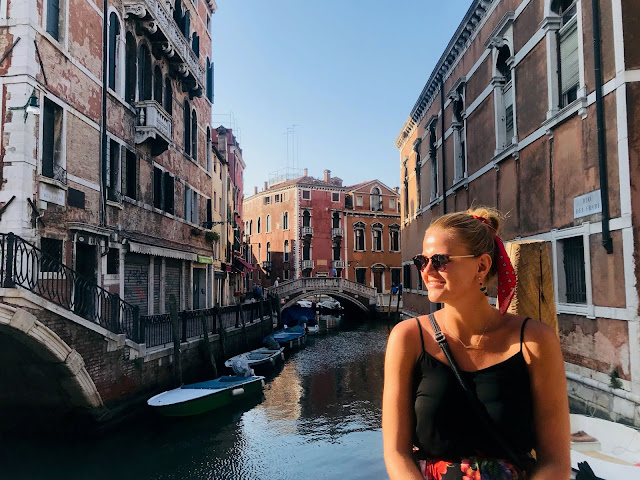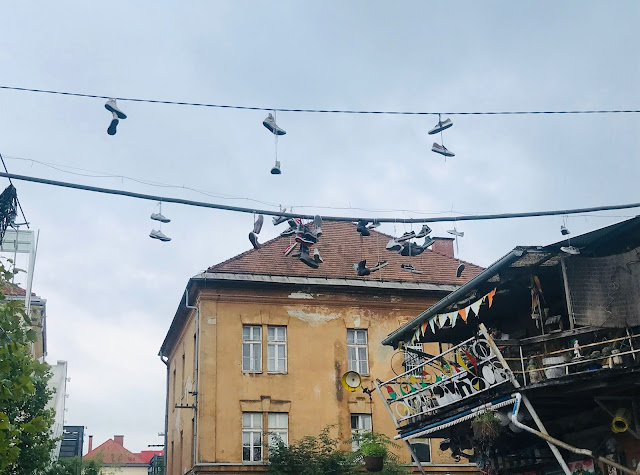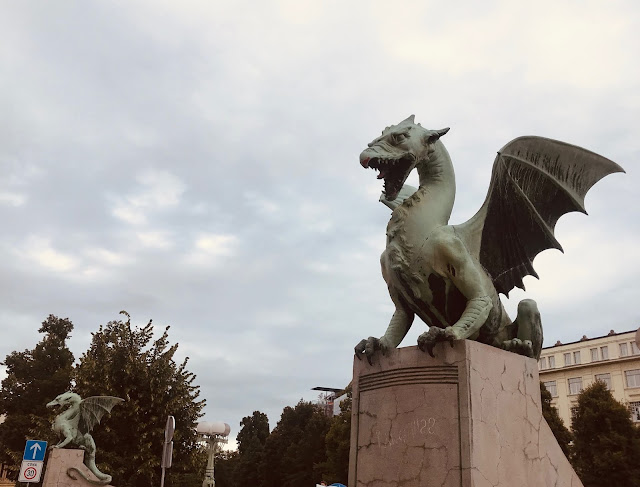August 2019
Good morning Venice!
Venice is a lovely, romantic, floating city. It's built on more than 100 small islands in a lagoon in the Adriatic Sea. It has no roads, just canals – including the Grand Canal. As there are no cars or buses or taxis, the transport is on the water: water-taxis, water-buses, gondolas.. Also, everything is easily reachable by walking.
We got to Venice early and took a train from mainland to the island part. For the few first hours when Venice was still waking up and tourists hadn't yet started roaming the streets, it was calm and peaceful to wander through the narrow labyrinths of streets and endless canals. By mid-day when it had gotten busy we had already booked ourselves a relaxing day-trip to three lovely islands nearby.
Piazza San Marco (Saint Mark's Square) lined with cafes, shops, and museums, bell tower, Palazzo Ducale and Basilica San Marco.
The Byzantine architecture basilica is dedicated to Venice's patron, the apostle Saint Mark.
The Bridge of Sighs aka “Ponte dei Sospiri"
It looks romantic but actually has a dark past. The baroque style bridge was built by Antonio Contin in 1614 and it connected the Doge’s Palace to the “New Prison”, the first building in the world to be designed specifically to serve only for detention. Detention often meant death, due to hard conditions and the cold within the stone walls of the prison, so the name of the bridge refers to the heavy sighs of the convicts crossing the bridge to go to prison.
On the boat tour, after 20-30 minutes, first stop was on Murano island to witness how the famous Murano glass is formed into vases, chandeliers and other decorative items. In the 13th century Venice's glassmakers were ordered to move to the island of Murano to reduce risk of fires in the city.
Burano
Probably the most colourful island I've ever been on.
Burano used to be a fishing village. Legend has it that people started painting their houses in bright colours so that fishermen coming home after exhausting work days could tell which house was theirs even in thick fog or completely drunk.
Apart from the colourfulness, Burano is also famous for its 16th century old lace making art that has been carried on over generations.
The leaning bell tower of San Martino church. The tilt is caused by land subsidence. It resembles the Leaning Tower of Pisa and has undergone several restorations and attempts to stop it from falling. Until 1867, the top of this tower was crowned by an angel which fell during a storm and is now replaced by an iron cross.
I'm still amazed by the beauty of this island. It's probably one of the most postcard perfect places on earth.
Torcello
Now largely abandoned, the island of Torcello once rivaled Venice in population and importance. It was the first of Venetian islands to be inhabited by people who fled the mainland to survive the Barbaric invasions. It was home for around 20,000 people from the 7th to 11th century. Nowadays, around two dozens of people live in tranquillity in Torcello.
Magnificent Basilica di Santa Maria Assunta church, built in 639 ad.
Some fried seafood with local beer enjoyed by sitting on the edge of one of the canals in the sun and fighting off seagulls. Still, perfect lunch.
Oh, and there is some superb gelato in Venice. That good, that I even forgot to take a photo. That, and it probably would have melted in the heat if I'd wasted time on photos.
As Venice is quite close to the border with Slovenia, it took round 3,5 hours by bus to get to Ljubljana. Hungry as we were, went pretty much straight to dinner. Balkan food is half the reason to go to Balkans. So so so delicious! Several people recommended Rio Momo, food was amazing, service on the other hand one of the weirdest I have witnessed.
Ljubljana is not a typical Balkans city, it's quite western and also quite expensive. Then again it makes sense as their average monthly salary is way higher than it is in Estonia.
The artsy Metelkova district. A rather unusual place just outside the city centre near the Ljubljana station. An alternative cultural scene has developed within the last decades in this empty former barracks complex. It resembles a little bit to Copenhagens Christiania, yet I'm not sure how liberal or not liberal the scene is in Ljubljana.
Dragon bridge. Legend has it that that Ljubljana was founded by Jason, the hero of Greek mythology. Jason and his Argonauts passed Ljubljana on their way to the Adriatic. Jason stopped at where Ljubljana is now situated and ended up fighting a dragon. Obviously, dragon became the symbol of the city. Apart from that bridge there are many more famous bridges in Ljubljana, one of them being the Triple bridge we crossed many times.







































Comments
Post a Comment